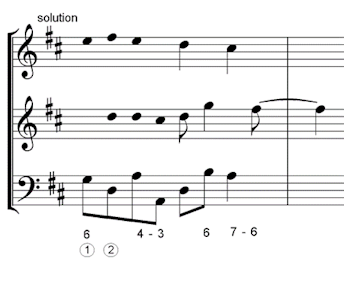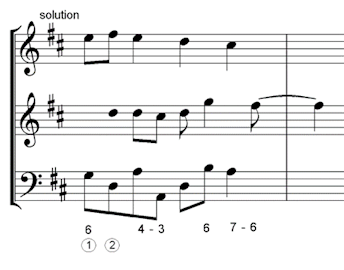Step 3. Roots, Thirds and Fifths
The next step is to look at each chord, aiming to find which part the root and third belong to.
- All chords need at least one root.
- All chords need at least one third except the final tonic chord at a cadence, where using three roots is common. (In a 4-3 suspension the third is replaced by the 4th).
- 5ths are usually optional, unless they are included in the figure itself (e.g. 6/3). Because they are optional, we will not try to add them at this stage unless it is obvious where they should go.
- In a 4-3 suspension, the 5th is normally the best option for the third note. The three notes are the root (in the bass), the 4th, and the 5th.
- The root or third might already be present in the bass, check there first.
- As always, avoid consecutives and augmented intervals. Move as smoothly as possible (2nds or 3rds), unless there is no alternative.
Work backwards from the parts you have already completed so far.
Here is an example. The stemless notes are the dissonances and resolutions already put in place. Looking at chord ②, we can see that the D major chord currently has two roots (D), but no third (F#), so the F# must go in the top part.

Looking at chord ①, the E minor chord is missing its root (E). The E will work fine in either of the top parts (it will move by step to F#, or to D). The other chord note is B (the 5th) and this would be better in the middle part, because a leap from B to F# in the top part is a large leap. So, we can be sure that the top part has an E, and the middle part can stay uncompleted for the moment (as the choice of B or E would depend on the chord previous to this one).

We can also add the 5th (E) into the 4-3 suspension chord, which is A major in root position.

At this stage it is likely that some of the rhythm will also start to become obvious. If this is the case, you can begin to add stems and beams where possible.
